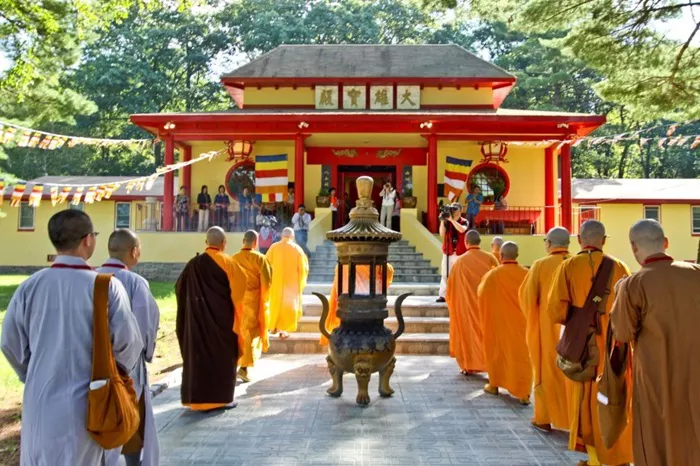Mahayana Buddhism is one of the largest branches of Buddhism, with millions of followers worldwide. It is distinct in its philosophy, practice, and understanding of the path to enlightenment. This article will explore what Mahayana Buddhism is, its origin, meaning, history, and the key principles that define it.
What is Mahayana Buddhism?
Mahayana Buddhism is a major tradition within Buddhism that emphasizes the potential for all beings to achieve Buddhahood. Unlike other schools of Buddhism, Mahayana encourages not only the pursuit of personal enlightenment but also the idea of helping others reach the same goal. This is why Mahayana is sometimes called the “Great Vehicle,” as it offers a more inclusive and expansive path to enlightenment.
The Core Belief of Mahayana Buddhism
The core belief of Mahayana Buddhism is that every person has the potential to attain Buddhahood. This differs from the Theravada tradition, where the focus is more on individual enlightenment. Mahayana emphasizes compassion and bodhicitta (the wish to attain enlightenment for the benefit of all beings) as essential qualities on the spiritual path.
The Origin of Mahayana Buddhism
The origins of Mahayana Buddhism can be traced back to around the 1st century CE in India. It arose as a response to earlier forms of Buddhism, especially the teachings of the Theravada tradition. Mahayana sought to expand the reach of Buddhism, making it more accessible to a broader audience. It also emphasized the importance of compassion and altruism in the path to enlightenment.
The Evolution of Mahayana Buddhism
Over time, Mahayana Buddhism spread to various parts of Asia, including China, Korea, Japan, and Vietnam. As it spread, the tradition adapted to local cultures and incorporated different elements, which led to the formation of diverse schools within Mahayana, such as Zen, Pure Land, and Tibetan Buddhism.
Key Scriptures of Mahayana Buddhism
The Mahayana tradition has several important scriptures, the most notable being the Lotus Sutra, the Heart Sutra, and the Diamond Sutra. These texts teach the importance of compassion, wisdom, and the ideal of the Bodhisattva, an enlightened being who seeks to help others achieve enlightenment.
The Meaning of Mahayana Buddhism
Mahayana Buddhism literally means “Great Vehicle” in Sanskrit. The term reflects the broad and inclusive approach of this tradition, which aims to guide all beings toward enlightenment. The “vehicle” refers to the path that one takes to reach Buddhahood, and the “great” part emphasizes that this path is not limited to a select few but is open to all sentient beings.
Bodhisattva Ideal in Mahayana Buddhism
In Mahayana, the ideal practitioner is known as a bodhisattva. A bodhisattva is someone who has attained a high level of spiritual development but chooses to remain in the cycle of birth and death (samsara) in order to help others attain enlightenment. This selfless path is central to Mahayana practice and is one of the key differences between it and other forms of Buddhism.
The Role of Compassion in Mahayana Buddhism
Compassion is a central tenet of Mahayana Buddhism. Practitioners believe that true enlightenment can only be achieved by helping others reach the same state of liberation. This focus on others is often described as the heart of Mahayana practice.
The History of Mahayana Buddhism
The history of Mahayana Buddhism is rich and complex, with many developments over time. It started in India, spread to Central Asia, China, Korea, Japan, and beyond, influencing various cultures and spiritual practices along the way. To learn more about the history and spread of Mahayana Buddhism, visit this link.
The Spread of Mahayana Buddhism Across Asia
As Mahayana Buddhism spread, it encountered different cultures and adapted to their spiritual needs. In China, it blended with Taoism and Confucianism, giving rise to unique schools like Chan Buddhism (later known as Zen in Japan). In Japan, the Pure Land and Nichiren traditions emerged, focusing on devotion to Amitabha Buddha and the chanting of mantras.
Key Figures in Mahayana Buddhism
Throughout history, many important figures have shaped the development of Mahayana Buddhism. Some of the most notable include Nagarjuna, a philosopher who articulated the concept of emptiness, and Shantideva, whose teachings on compassion are central to Mahayana practice.
Modern Mahayana Buddhism
Today, Mahayana Buddhism continues to thrive worldwide. It has a significant presence in East Asia, with millions of followers in countries like China, Korea, Japan, and Vietnam. In recent decades, Mahayana Buddhism has gained recognition in the West, where many people have been drawn to its emphasis on compassion and mindfulness.
Mahayana Buddhism in the West
In the Western world, Mahayana Buddhism has become increasingly popular, particularly through the practice of meditation and mindfulness. Many people in Western countries are drawn to the teachings of Zen and Tibetan Buddhism, which are both branches of Mahayana. These teachings often focus on meditation as a means to cultivate mindfulness, reduce stress, and increase awareness.
Conclusion
In conclusion, Mahayana Buddhism is a broad and inclusive tradition that emphasizes compassion, altruism, and the potential for all beings to achieve Buddhahood. With its rich history, diverse schools of thought, and deep spiritual insights, Mahayana Buddhism offers a path to enlightenment that is accessible to everyone. Whether you’re exploring the teachings of the meaning of Mahayana Buddhism or delving into its fascinating history, this tradition remains a powerful source of wisdom and guidance in the modern world.

